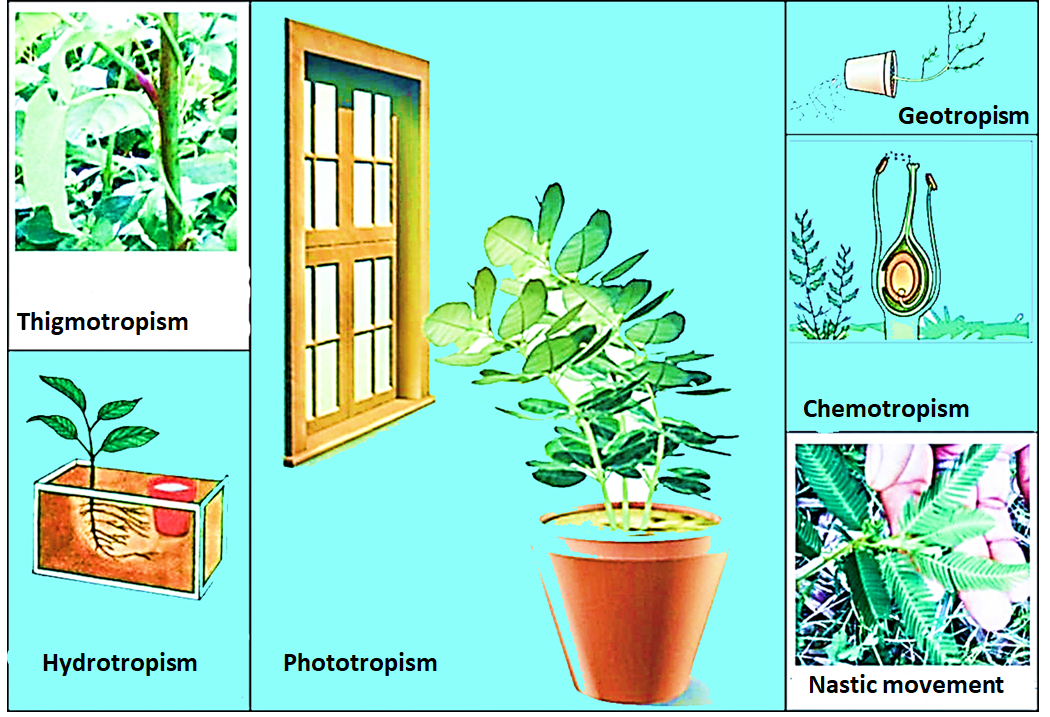
Describe the various movements of plants with suitable examples.
Answer
486k+ views
Hint: Plants react to various stimuli such as light, from their external environment. In response, they show various movements in the form of bending, twisting, and elongation of certain plant parts or organs.
Complete answer:
The plants are fixed at a place with their roots in the ground, so they cannot move from one place to another and hence cannot show locomotion. (movement of the entire body). But plants can move their Individual parts.
The two types of plant movements are:
Tropic movement: The movement of a plant in the direction of stimulus is known as Tropic movement or tropism.
Types of tropism are as follows:
Hydrotropism: Movement due to water. An example is the movement of roots Towards the water source.
Phototropism: Movement due to light. An example is the Growth of aerial parts of plants towards light.
Chemotropism: Movement due to chemical energy. An Example is During the process of fertilization, the movement of the Pollen tube towards the Ovule due to the secretion of a sugary chemical in the ovary.
Geotropism: Movement due to soil. An Example is the Growth of fruits of plants in a downward direction.
Nastic movements: These are non-directional movements That take place neither towards or away from the stimulus. The best example of this is the folding and dropping of leaves of the ‘touch me not' plant when its leaves are touched with fingers.
Note: Movements are defined as the change in position of an Organism with respect to its surroundings. Whereas, the movement of an organism from one place to another is called locomotion. Thus, we can say that every locomotion is movement but every movement is not locomotion.

Complete answer:
The plants are fixed at a place with their roots in the ground, so they cannot move from one place to another and hence cannot show locomotion. (movement of the entire body). But plants can move their Individual parts.
The two types of plant movements are:
Tropic movement: The movement of a plant in the direction of stimulus is known as Tropic movement or tropism.
Types of tropism are as follows:
Hydrotropism: Movement due to water. An example is the movement of roots Towards the water source.
Phototropism: Movement due to light. An example is the Growth of aerial parts of plants towards light.
Chemotropism: Movement due to chemical energy. An Example is During the process of fertilization, the movement of the Pollen tube towards the Ovule due to the secretion of a sugary chemical in the ovary.
Geotropism: Movement due to soil. An Example is the Growth of fruits of plants in a downward direction.
Nastic movements: These are non-directional movements That take place neither towards or away from the stimulus. The best example of this is the folding and dropping of leaves of the ‘touch me not' plant when its leaves are touched with fingers.
Note: Movements are defined as the change in position of an Organism with respect to its surroundings. Whereas, the movement of an organism from one place to another is called locomotion. Thus, we can say that every locomotion is movement but every movement is not locomotion.

Recently Updated Pages
The correct geometry and hybridization for XeF4 are class 11 chemistry CBSE

Water softening by Clarks process uses ACalcium bicarbonate class 11 chemistry CBSE

With reference to graphite and diamond which of the class 11 chemistry CBSE

A certain household has consumed 250 units of energy class 11 physics CBSE

The lightest metal known is A beryllium B lithium C class 11 chemistry CBSE

What is the formula mass of the iodine molecule class 11 chemistry CBSE

Trending doubts
Describe the effects of the Second World War class 11 social science CBSE

Which of the following methods is suitable for preventing class 11 chemistry CBSE

How do you find the distance between two parallel lines class 11 maths CBSE

Why do you think did the narrator call lie Amsterdam class 11 english CBSE

Tentacles of Hydra are A Hollow B Solid C Half hollow class 11 biology CBSE

What do you mean by public facilities




